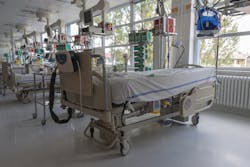To support the COVID-19 response, standards organization HL7 and health IT vendor Audacious Inquiry are working to develop a FHIR Implementation Guide for a project designed to automate transmission and enable real-time exchange of de-identified data among healthcare organizations and public health authorities.
The effort is being coordinated through an initiative called the Situation Awareness for Novel Epidemic Response (SANER) Project. The SANER Project brings together thought leaders in health IT and disaster response to enable the secure and rapid transfer of information about hospital bed capacity and availability of critical resources during public health emergencies.
The project will seek to empower global developers to collaborate on the COVID-19 response through shared interoperability standards based on HL7 FHIR. Healthcare facilities, critical infrastructure and government response authorities can leverage these standards to expose data that is critical for controlling the spread of the disease and managing limited healthcare resources across the country. Baltimore-based Audacious Inquiry is leading the development of open source solutions that will follow the SANER HL7 FHIR Implementation Guide.
In a recent interview with Healthcare Innovation, Scott Afzal, Audacious Inquiry’s president, described the project’s origins. He said it actually grew out of work his company has done on a project called PULSE for the Office of the National Coordinator that started when Karen DeSalvo, M.D., was national coordinator. The PULSE platform ensures that qualified healthcare professionals and emergency responders can rapidly and securely access health records as they care for displaced populations during and after disasters.
“That work is as relevant as it has ever been, but grew out of some questions Karen asked us when she was coordinator in terms of how we could leverage all the investments from the HITECH Act in interoperability to support preparedness and response, given her experience in Louisiana during Katrina,” Afzal said. “The first part of that work was traveling throughout the Gulf Coast and California and coming up with the idea of PULSE, and through that work, we got exposed to folks in the HHS Office of the Assistant Secretary for Preparedness and Response (ASPER), and some of the challenges they deal with on a regular basis, including resource management and planning from a bed-availability perspective.”
As they thought about the options available, they saw that the current state of the art is highly manual in terms of how hospitals report bed resource availability. “Our core business is dealing with ADT (admit, discharge, transfer) data. Our first idea was that maybe you could take all that real-time ADT message flow data and calculate bed availability,” Afzal explained. “We started working on that with MITRE to analyze if that was feasible. Ultimately, we determined that it wasn’t feasible in the way that the need is articulated by ASPER and others that have these bed resource availability needs. But as FHIR resources started becoming more prevalent, we started thinking about whether that could be applicable here. We decided that to build a fully scalable and extensible bed and resource availability solution, you should rely on these modern FHIR and API frameworks. About a year and a half ago we started thinking through a model where you could take an existing FHIR resource, bring it to the standards community, organize around how you might need to modify it to include other relevant content,” he continued. “If this were a national priority, we could work with Epic and Cerner to get it implemented.” At the time this wasn’t a high priority, but now it is.
The tool will probably take 60 to 90 days to begin piloting, Afzal said. “We should be talking about building solutions for the fall and thereafter, not just planning for the immediate crisis. We have to see if the broad community continues to engage on the project and if they think this is the right approach and the vendor community stays at the table. There is a lot of work to get from here to there. But there are so many collaborators who have come to the table to work on the Implementation Guide that it shows promise.”
PULSE-COVID Edition
In December ONC awarded Audacious Inquiry a contract for expansion of the PULSE platform. Lauren Knieser, director of emergency preparedness and response for Audacious Inquiry, described how the platform is being used in the COVID response.
“We are seeing a lot more interest in uptake,” she said. “Everybody wants a solution when they have a disaster on their hands. For the original PULSE product on the market, the idea was that it would provide the ability to query the national networks for medication and health history for alternate care sites or settings where care is being provided but there is not a connection to an EHR, such as medical shelters or quarantine sites.
“For COVID, we are seeing that there is also a public health use case,” she said. “We are seeing that where there are alternate care sites being planned and executed across the country, there is interest in deploying PULSE there. In addition, public health is struggling to acquire useful data for clinical case augmentation, for understanding the progression of disease and in some cases for even more basic issues such as attaching demographic information to known COVID cases. We have been talking to several states about how they can use PULSE COVID edition to query across national networks for some of that data.”
She described the COVID edition as a solution that is rapidly deployable. “Our regular PULSE product has many more features, and offers a single-sign-on option and connections to regional HIEs — things that take a little longer to get up and running. The PULSE COVID edition basically strips a lot of that out and allows a lot of the same search functionality that PULSE regularly provides but has a much simpler user interface and can be turned on within days.”
Some public health organizations are having difficulty getting data because there is confusion about what types of data health providers can share with public health agencies during an emergency. “It seems that there is a lot of misinformation out there about what is allowable to be shared with public health when there is an emergency declaration,” Knieser said. “I find myself bringing that language out and showing people that public health authorities are in fact able to see information about patients.
“The issue with ‘minimum necessary’ comes into play because there is not a ton of guidance about what constitutes minimum necessary — in particular when we query across the national networks,” she explained. “Those queries need to be labeled as either treatment queries or public health queries. If they are put out as public health queries, we are seeing that not every organization that participates in the network responds with the documents they have or they respond with only a subset of the documents available. That is something ONC is definitely working on from a policy standpoint. I know they have had conversations with the Office for Civil Rights. I don’t know where that stands. There is a lot of movement in the industry to clarify what minimum necessary means or to enable these queries to go out as treatment queries because in effect when you are providing information to public health to do contact tracing and outreach, that is part of care coordination.”


